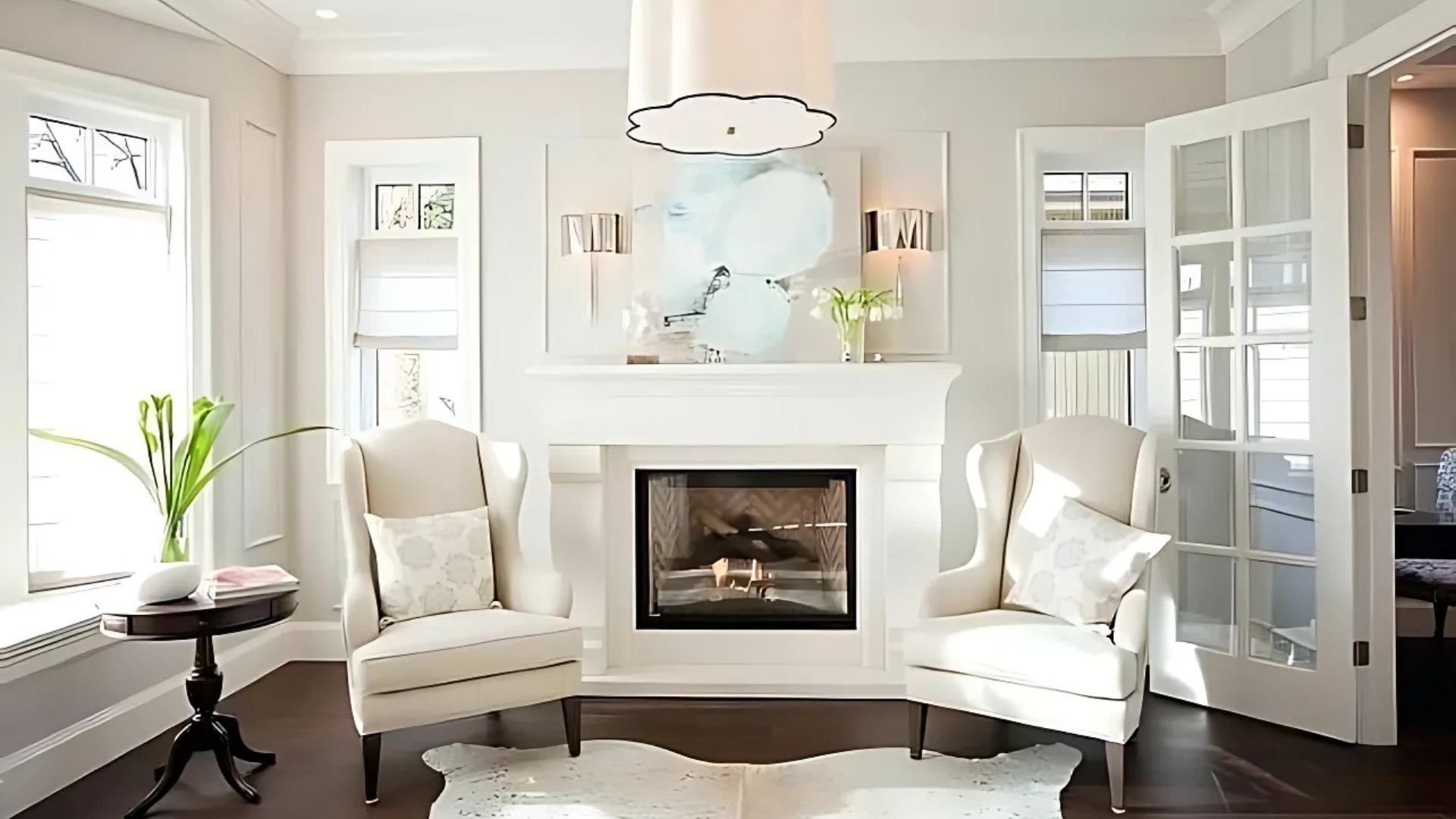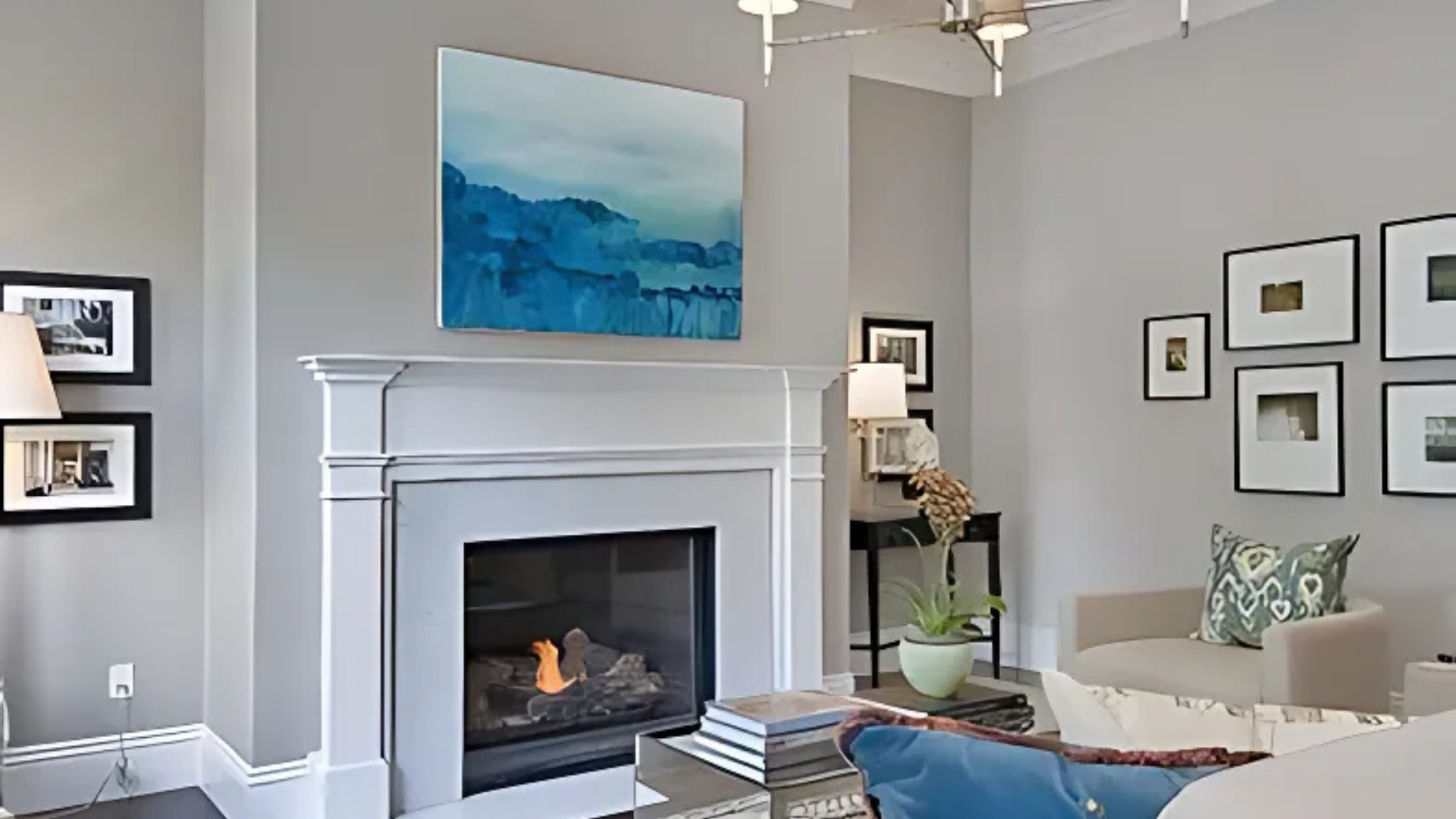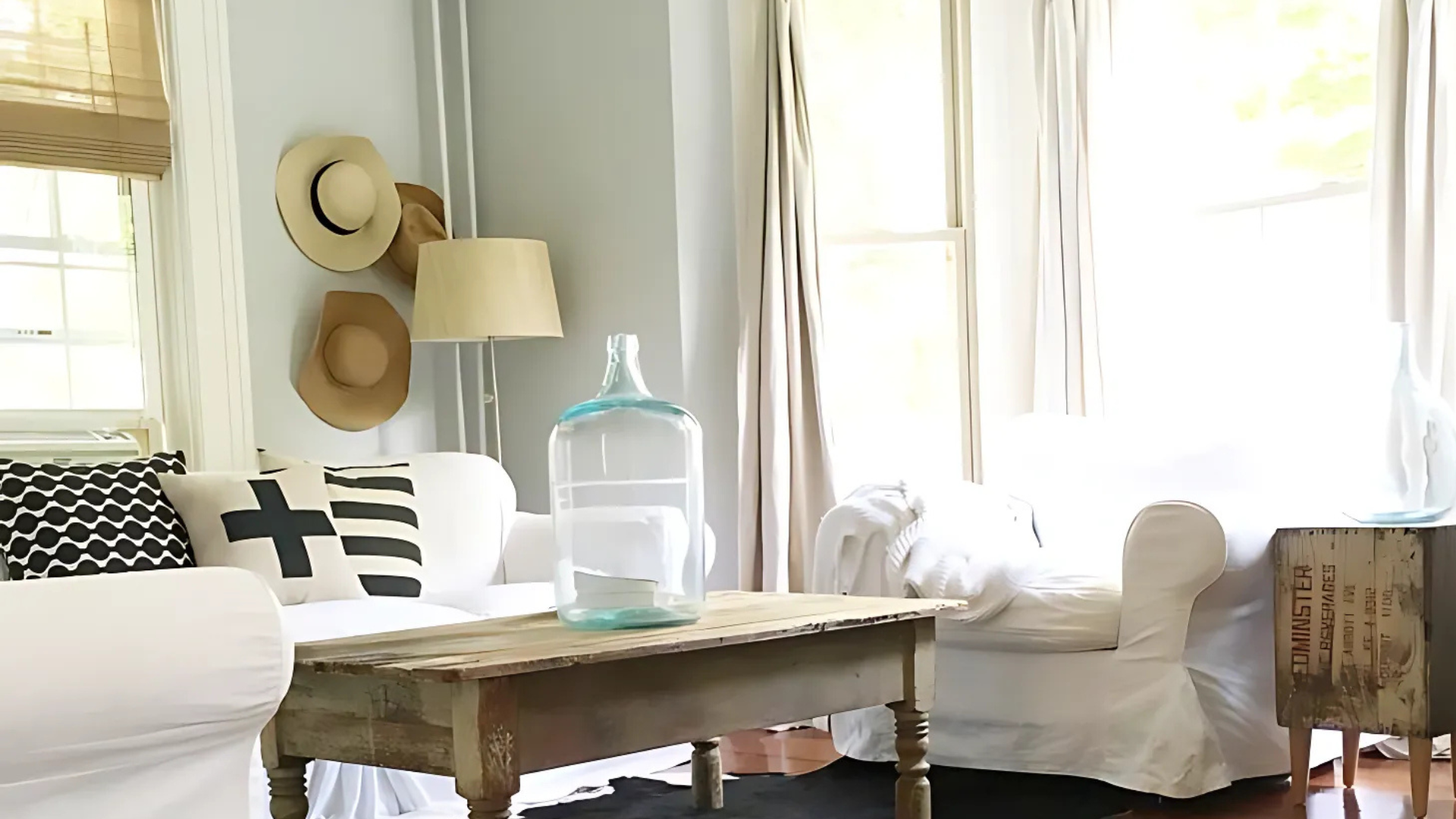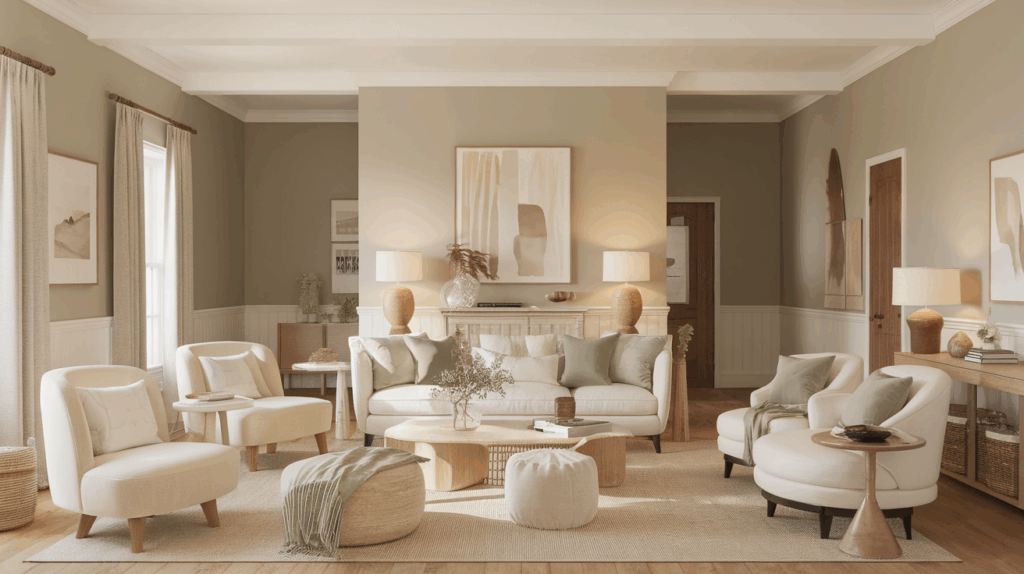Some grays can feel flat or cold, but Benjamin Moore’s Oyster Shell brings something different. This color has a soft look that adds warmth without feeling heavy. It works well in many homes and can help create a space that feels steady and relaxed.
Oyster Shell is a gentle gray with warm undertones. It can change slightly depending on the light, but it always feels calm. The color doesn’t stand out too much, which helps it blend into different parts of the home.
People often choose it for walls, trim, or even cabinets. It pairs well with wood floors, soft fabrics, and warm lighting. Oyster Shell gives just enough color to keep a room from feeling dull.
If you’re looking for a gray that feels smooth and easy to live with, this one is a strong choice. It’s simple, steady, and easy on the eyes.
Why Oyster Shell Is the Perfect Choice for Your Space?

Oyster Shell is a soft gray paint color that brings a quiet feel to any room. It doesn’t come off too cold or too dark, making it easy to use in homes that need something neutral but not plain. Its balanced tone helps rooms feel calm without feeling dull.
Many people pick Oyster Shell because it:
- Has warm undertones that keep the color from feeling icy
- Blends well with wood, metal, and fabric
- Looks good in both bright and low light
- Works in many styles, including modern and classic homes
- Makes rooms feel steady and pulled together
The Undertones of Oyster Shell
Oyster Shell is a soft gray with warm undertones that lean slightly into beige. These undertones help the color feel grounded and steady without making the room look dark. It has just enough warmth to keep the space from feeling cold or flat.
In bright light, Oyster Shell can appear closer to a light gray. It stays soft and natural, never too bold or bright. This makes it useful in open spaces or large rooms where you want the walls to feel calm.
In dim lighting, the warmth becomes more visible. The gray takes on a gentle, almost creamy base that makes the room feel settled. This helps it stay pleasant throughout the day, no matter how the light changes.
Oyster Shell LRV: Light Reflectance Value Explained
The Light Reflectance Value (LRV) of Oyster Shell is 67.87. That means it reflects a moderate amount of light, more than darker colors but less than pale whites or creams. It helps bring brightness into a space without being too strong.
This level of light reflection makes it a helpful choice for rooms that feel a little dim or closed in. It keeps walls from feeling heavy while still offering solid coverage. It also holds up well under natural light and artificial light alike.
Because the LRV sits in the middle range, Oyster Shell is easy to use in both small and large rooms. It helps create balance by adding light without washing out. The warm tone also softens the effect, keeping it easy on the eyes.
The Psychology of Oyster Shell: How It Affects Your Mood
Oyster Shell brings a soft and calming feel to a space. It’s not a color that grabs attention, and that’s part of what makes it helpful in busy homes. It creates a quiet setting that supports focus, relaxation, or everyday living.
The warm base makes the room feel more welcoming. While some grays can feel cold or stiff, Oyster Shell has a more natural tone that adds comfort without becoming too dark. It works well in spaces where people want to feel settled.
This color is a good fit for bedrooms, family rooms, and home offices. It brings peace without making the room feel dull or lifeless. It’s a color that supports the space instead of dominating it.
How does Oyster Shell look in Different Lighting?

Light plays a significant role in determining the appearance of Oyster Shell. In north-facing rooms, the light is cooler, which can make the paint appear slightly grayer. But even then, it keeps a soft tone that doesn’t feel too sharp.
In south-facing rooms, where sunlight is strong for most of the day, Oyster Shell feels warmer. The beige undertones become a little more noticeable, helping the room feel more relaxed and balanced. It holds its color well without becoming too yellow.
East- and west-facing rooms bring different light throughout the day. In the morning, east-facing rooms will make Oyster Shell look clean and calm. In the afternoon, the west-facing light gives the color a richer tone, adding a quiet warmth to the space.
Where Is Oyster Shell Best Used in an Interior?
Due to its soft tone and natural appearance, Oyster Shell is suitable for use in many rooms. It can be used from top to bottom, including walls, trim, ceilings, and even cabinets. It helps brighten low-light rooms and tones down overly bright ones.
Some of the best places to use Oyster Shell include:
- Living rooms, where it pairs well with natural wood and soft lighting
- Bedrooms, offering a calm look for rest and comfort
- Kitchens, where it works well with both light and dark cabinets
- Bathrooms, giving a clean look without feeling too plain
- Hallways and entryways, to create flow between rooms
- Ceilings and trim, for a smooth and soft look all around
No matter where it’s used, Oyster Shell adds a quiet background that lets the rest of the room stand out.
What Kind of Floors Would Look Best with Oyster Shell?
The floor you choose can change how Oyster Shell looks in your space. This gray paint color has warmth to it, so picking the right flooring helps keep the whole room in balance. The goal is to match the tone, not fight against it.
Flooring choices that work well with Oyster Shell:
- Light wood floors like oak or ash to keep the space feeling open
- Medium brown wood for a natural, grounded look
- Warm gray tiles to bring out the paint’s soft side
- Beige or taupe carpet for a gentle and smooth match
- Whitewashed or weathered floors for a laid-back feel
- Natural stone that adds texture without clashing
With the right floor, Oyster Shell helps create a space that feels steady and easy to spend time in.
How to Incorporate Oyster Shell Into Your Home Decor?

Oyster Shell works well as a base color because it doesn’t take over the room. Its soft look makes it easy to add furniture, fabrics, and accents without clashing. The warm undertones help it blend with many styles and color schemes.
One way to use it is on the walls, paired with natural wood furniture. This keeps the space grounded and simple. You can also use soft fabric tones, such as cream, beige, or muted greens, to keep things balanced.
Accent pieces, such as metal lighting, black frames, or soft blue pillows, can add contrast without looking out of place. Warm light bulbs will bring out the paint’s soft tone, making the room feel even more settled.
With these simple touches, Oyster Shell helps create a space that feels calm and well-put-together.
Oyster Shell vs. Other Warm Grays
Oyster Shell is often compared to other popular warm grays, such as Revere Pewter and Edgecomb Gray.
While all three come from the same general color family, each has its own tone and feel. Small differences in warmth, depth, and lighting behavior can significantly alter the appearance and ambiance of a room.
| Feature | Oyster Shell (864) | Revere Pewter (HC-172) | Edgecomb Gray (HC-173) |
|---|---|---|---|
| Undertone | Warm with beige hints | Warm with a green undertone | Warm with a touch of taupe |
| Brightness | Medium, soft look | Slightly deeper and earthier | Lighter and more airy |
| Best For | Calm spaces and neutrals | Richer walls and trim | Light, open room designs |
| Light Behavior | Soft and balanced in all light | It can look darker in low light | Brightens in sunny rooms |
Each of these colors brings a warm, natural feel, but Oyster Shell sits between the deeper tone of Revere Pewter and the light feel of Edgecomb Gray. It’s a steady choice when you want something soft but not too pale or dark.
Conclusion
Oyster Shell by Benjamin Moore is a soft gray that works well in a variety of rooms. It has warm undertones that keep it from feeling too cool or too bold. That makes it a useful option for people who want color but still want their space to feel calm.
This shade reacts well to both sunlight and indoor lighting. It works on walls, trim, and even furniture. It also pairs well with various floor types, including warm wood, tile, and carpet.
People like it because it doesn’t try too hard—it fits in without taking over. It makes rooms feel balanced and easy to enjoy. It’s also easy to pair with other colors, making it easier to create a cohesive look.
For anyone seeking a soft gray that remains consistent in various settings, Oyster Shell is a wise choice. It gives just the right amount of warmth, helping homes feel more settled and complete.
Frequently Asked Questions
Can Oyster Shell Be Used on Furniture?
Yes, Oyster Shell works well on furniture like dressers, nightstands, and built-in shelves. Its soft tone adds color without standing out too much, making it a great choice for pieces that need a neutral finish.
Is Oyster Shell a Good Choice for Open Floor Plans?
Oyster Shell is a solid option for open layouts because it flows well from room to room. It keeps the space feeling connected while allowing for other colors and textures to be used in each area.
Does Oyster Shell Work with Black or Dark Fixtures?
Yes, black or deep bronze fixtures pair nicely with Oyster Shell. The warm gray base balances the darker accents, providing the room with contrast without too much sharpness.
What Finish Should I Use with Oyster Shell on Walls?
For most walls, eggshell or matte finishes work well with Oyster Shell. They offer a soft appearance that complements the natural tone of the color, while remaining easy to clean.

